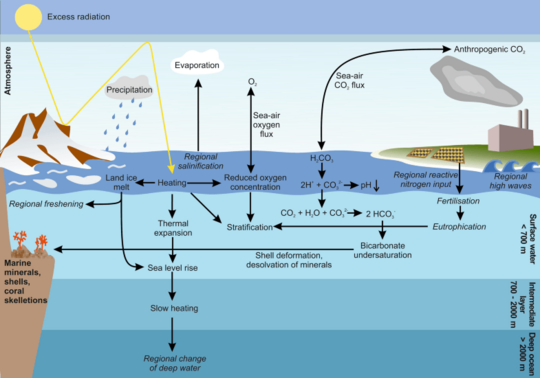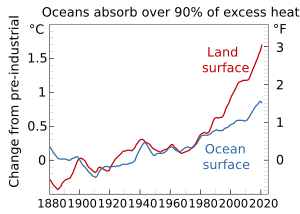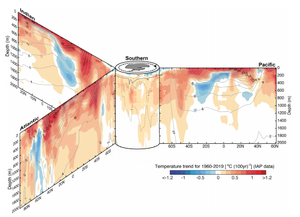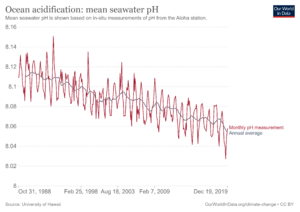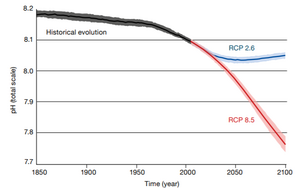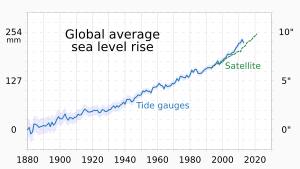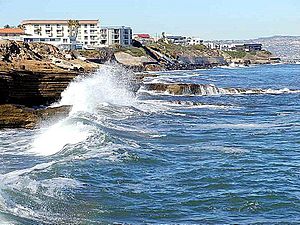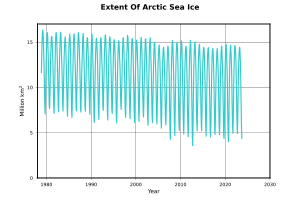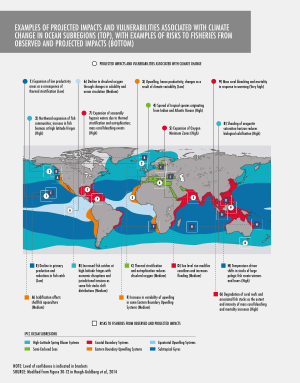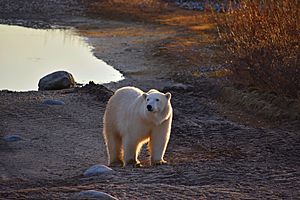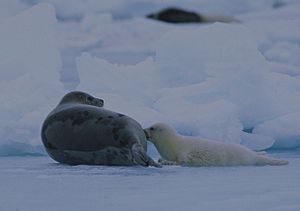Effects of climate change on oceans facts for kids
Climate change is having a big impact on our oceans. One of the main changes is that the ocean water is getting warmer. This leads to more frequent marine heatwaves, which are like heatwaves on land but in the sea. Warmer water also makes sea levels rise. Other important changes include the ocean becoming more acidic, sea ice melting, and less oxygen in the water. Even ocean currents are changing. All these shifts affect marine life and ecosystems. The main reason for these changes is human activity, especially the release of greenhouse gases like carbon dioxide and methane. The ocean absorbs most of the extra heat and some of the extra carbon dioxide from the air. This causes the ocean's pH level to drop, making it more acidic. Scientists believe the ocean has absorbed about a quarter of all human-made CO2 emissions.
When the ocean surface warms up, the different layers of ocean water don't mix as well. This means warm water stays near the surface, and cold, deep water doesn't circulate as much. This reduced mixing makes it harder for the ocean to absorb heat, so more heat stays in the atmosphere and on land. It also means less food (nutrients) for fish in the upper ocean layers. Plus, the ocean's ability to store carbon is reduced.
Warmer water can't hold as much oxygen as cold water. So, as the ocean warms, oxygen moves from the water into the air. Also, when ocean layers don't mix well, less oxygen from the surface reaches deeper waters. This makes the water's oxygen content even lower. The ocean has already lost oxygen, and areas with very low oxygen, called oxygen minimum zones, are growing around the world.
These changes hurt marine ecosystems, which are like underwater neighborhoods for plants and animals. This can lead to some species disappearing or others growing too much, changing where different animals live. It also affects coastal fishing and tourism. Rising water temperatures harm important places like coral reefs. Even a small temperature increase can cause coral bleaching, where corals turn white and can die. Ocean acidification and warming also affect where species live and how much food is available, which threatens fisheries and upsets marine ecosystems. Losing sea ice homes due to warming greatly impacts many polar animals that depend on it.
How Greenhouse Gases Change Our Oceans
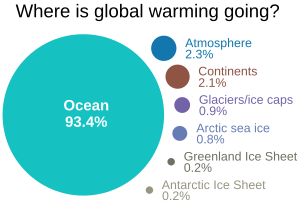
Today, the amount of carbon dioxide (CO2) in the air is nearly 50% higher than before the Industrial Revolution. These high levels are unlike anything seen in the last 55 million years! We know this extra CO2 comes from human activities like burning fossil fuels and changing land use. Scientists have known since the 1950s that the ocean absorbs a lot of this human-made CO2.
Recent findings from 2019 show that:
- The global ocean has been warming steadily since 1970, taking in over 90% of the extra heat in the climate system.
- Since 1993, the ocean has been warming more than twice as fast.
- Marine heatwaves have likely doubled in how often they happen since 1982 and are getting stronger.
- By absorbing more CO2, the ocean surface is becoming more acidic.
- Oxygen levels have dropped from the surface down to 1000 meters deep.
Ocean Temperatures Are Rising
The ocean is clearly warming because of climate change, and this warming is speeding up. In 2022, the global ocean was the warmest it had ever been since we started recording. This steady rise in ocean temperatures is happening because of an energy imbalance on Earth, mainly caused by more greenhouse gases in the air. Between the time before industries started and the years 2011-2020, the ocean's surface warmed by about 0.68 to 1.01 degrees Celsius.
The upper part of the ocean (down to about 700 meters) is warming the fastest, but warming is happening everywhere. Most of the ocean's heat gain is in the Southern Ocean. For example, from the 1950s to the 1980s, the Antarctic Southern Ocean warmed by 0.17 degrees Celsius, which is almost twice as fast as the global ocean.
What is Ocean Heat Content?
Ocean temperature varies from place to place. It's warmer near the equator and colder at the poles. So, looking at the total ocean heat content is the best way to see how much the ocean is warming. The amount of heat the ocean has absorbed increased between 1993 and 2017 compared to 1969-1993.
Ocean Acidification
When the ocean absorbs carbon dioxide from the atmosphere, it becomes more acidic. This is like adding vinegar to water; it lowers the pH level. This change in ocean chemistry is called ocean acidification. It makes it harder for some marine animals to build their shells and skeletons.
Physical Changes in the Ocean
Sea Level Rise
Many cities along the coast will experience more flooding in the coming decades. This is because sea levels are rising. Sometimes, the land itself is sinking, which makes coastal flooding even worse. By 2050, hundreds of millions of people, especially in Southeast Asia, could be threatened by coastal flooding.
Changing Ocean Currents
Ocean currents are like giant rivers in the sea. They are caused by differences in water temperature, winds, and the saltiness of the water. Warm air rises near the equator and cools as it moves toward the poles. Cool air sinks near the poles and warms up as it moves toward the equator. These air patterns create winds that push surface water to colder areas. There, the water cools, becomes very dense, and sinks to the ocean floor.
This sinking and rising of water, along with the wind, creates ocean currents that move water all around the world. When the ocean warms and glaciers melt, more fresh water enters the areas where deep water forms. This fresh water is less dense, so the water sinks more slowly than usual.
Changes in ocean currents affect how well the ocean can absorb carbon dioxide and how much food is available for marine life. This is because currents move nutrients around.
Increasing Stratification
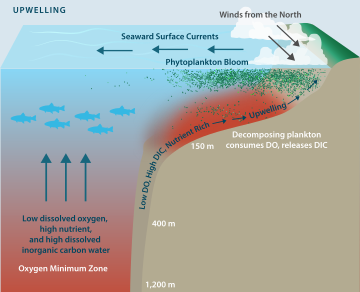
Ocean stratification means the ocean water separates into layers based on how dense it is. This happens in all ocean basins. These layers limit how much water mixes vertically, which reduces the exchange of heat, carbon, oxygen, and tiny particles between the upper ocean and deeper parts. Since 1970, the upper ocean has become more stratified due to global warming and, in some areas, changes in saltiness.
Stratification is important because it controls how nutrients move from deep water to the surface, which helps ocean life grow. It also affects how oxygen from the air and surface waters gets into the deep sea.
Reduced Oxygen Levels
Climate change affects oxygen in both coastal areas and the open ocean.
The open ocean naturally has some areas with low oxygen, called oxygen minimum zones. These areas are cut off from oxygen in the air because ocean currents are slow there. Also, oxygen is used up when dead organic matter from the surface sinks and breaks down. These low-oxygen areas are growing because the ocean is warming. Warmer water holds less oxygen and mixes less, making the problem worse.
Overall, ocean oxygen levels are estimated to have dropped by 2% over 50 years since the 1960s. Low oxygen is stressful for almost all marine animals. Very low oxygen levels create areas with much less animal life. Scientists predict these low-oxygen zones will expand in the future, which is a serious threat to marine life.
Another concern is in coastal waters. More nutrients from rivers flowing into coastal areas lead to more plant growth. When these plants die and sink, they use up oxygen as they break down. This can create extreme oxygen depletion, sometimes called dead zones. These dead zones are growing, mainly due to more nutrient pollution, but also made worse by increasing ocean stratification from climate change.
Oceans Turning Green
Satellite images show that the oceans have been slowly changing color from blue to green as climate change continues. This color change has been seen across most of the world's ocean surfaces. It might be due to changes in tiny ocean plants (plankton) caused by climate change.
Changes to Earth's Weather and Wind Patterns
Climate change and the warming ocean will lead to big changes in Earth's weather, including stronger tropical storms and monsoons, and more extreme weather. Some areas will get wetter, others drier. Changing wind patterns are also expected to make waves taller in some places.
Stronger Tropical Cyclones
Human-caused climate change keeps warming the oceans. Warmer ocean water and higher sea surface temperatures give tropical cyclones more energy. This makes them more intense, bigger, last longer, and cause much more flooding rain. Hurricane Harvey in 2017 is an example of this.
Salinity Changes
Salinity is how much salt is in seawater. Salt doesn't evaporate, so the amount of rain and evaporation strongly affects salinity. Changes in the water cycle are clearly seen in surface salinity measurements.
Long-term observations show a clear trend: global salinity patterns are becoming more extreme. This means salty areas are getting saltier, and less salty areas are getting even less salty. In salty regions, evaporation is increasing. In less salty regions, more rain is falling.
Sea Ice Decline
Sea ice is melting more in the Arctic than in Antarctica, where the conditions are more about changing sea ice rather than just decline. Arctic sea ice has been shrinking rapidly. This loss of ice affects the animals that depend on it.
Impacts on Marine Life
Climate change will not only affect the total amount of life in the ocean but also how different groups of animals and plants are distributed. In general, species are expected to move towards the poles as the water warms. Some species have already moved hundreds of kilometers since the 1950s. The timing of phytoplankton blooms (tiny ocean plants) is also changing, happening earlier in the season, especially in polar waters. These trends are expected to get stronger as climate change continues.
There are also important impacts on seabirds, fish, and mammals in polar regions. Animals with very specific ways of surviving will need to adapt to big changes in their homes and food supply. Sea ice is often crucial for their life cycle. For example, in the Arctic, it provides resting spots for seals and walruses, and hunting routes for polar bears. In the Antarctic, seabird and penguin populations are also very sensitive to climate change.
Due to a marine heatwave in the Pacific Northwest from 2019-2021, snow crab populations in the Bering Sea dropped by 84% between 2018 and 2022. This was a loss of 9.8 billion crabs.
Coral Reefs

While some marine animals can move to new places when the climate changes, corals find this much harder. A coral reef is an underwater ecosystem built by corals. Reefs are important places for many different kinds of life and are vital for millions of people who rely on them for coastal protection, food, and tourism.
Warm water corals are clearly declining. About 50% have been lost over the last 30-50 years due to many threats, including ocean warming, ocean acidification, pollution, and physical damage from activities like fishing. These problems are expected to get worse.
Warming ocean surface waters can lead to coral bleaching, which can seriously damage or kill corals. The IPCC report in 2022 found that "Since the early 1980s, mass coral bleaching events have become much more frequent and severe worldwide." Marine heatwaves have caused many corals to die. It is expected that many coral reefs will suffer irreversible changes and loss if global temperatures increase by more than 1.5 degrees Celsius.
Coral bleaching happens when warm ocean water stresses corals, causing them to kick out the tiny algae that live inside their tissues. These algae give corals their bright colors. A sustained increase of just 1-2 degrees Celsius in seawater temperature is enough for bleaching to occur, which turns corals white. If a coral is bleached for too long, it can die. In the Great Barrier Reef, there were no such events before 1998. The first one happened in 1998, and after that, they started happening more often. Between 2016 and 2020, there were three major bleaching events.
Besides bleaching, the ocean becoming more acidic is also a problem for coral reefs. It reduces the variety of coralline algae, which are important for reef health.
Ocean Productivity
The process of photosynthesis in the surface ocean releases oxygen and uses up carbon dioxide. This photosynthesis is mainly done by phytoplankton – tiny floating algae. After these tiny plants grow, bacteria break down the organic matter they formed, which uses up oxygen and releases carbon dioxide. When some of this organic matter sinks into deep ocean water, where it's not in contact with the air, it leads to less oxygen and more carbon dioxide. This cycling of carbon dioxide in oceans is a key part of the global carbon cycle.
Photosynthesis in surface waters uses nutrients (like nitrogen and phosphorus). These nutrients are then transferred to deep water when the organisms die and sink. So, how much life grows in surface waters depends partly on how nutrients are brought back to the surface from deep water by ocean mixing and currents. The increasing stratification of the oceans due to climate change generally reduces how much life can grow in the ocean. However, in some areas, like those previously covered by ice, productivity might increase. This trend is already visible and is expected to continue. For example, in the Indian Ocean, productivity is estimated to have dropped over the past sixty years due to climate warming and is expected to continue.
If emissions are very high, ocean productivity is very likely to drop by 4-11% by 2100. This decline will vary by region. For example, tropical ocean productivity will drop more, by 7-16% in the same high-emission scenario. Less organic matter will likely sink from the upper oceans into deeper layers because of increased ocean stratification and less nutrient supply. The reduction in ocean productivity is due to the "combined effects of warming, stratification, light, nutrients, and animals eating each other."
Effects on Fisheries
Climate change affects fisheries in many ways. Warmer waters can change where fish live, making them move to cooler areas. This can impact fishing communities that rely on certain fish species. Ocean acidification also makes it harder for shellfish to grow their shells, which can harm those fisheries.
Harmful Algal Blooms
Harmful algal blooms (HABs) are when certain types of algae grow very quickly and produce toxins that can harm marine life, humans, and the environment. While we don't fully understand what causes them, they seem to have increased in how often they happen and how far they spread in coastal areas since the 1980s. This is partly due to human factors like increased nutrient pollution and climate change, especially warmer water temperatures. The conditions that lead to HABs include ocean warming, marine heatwaves, oxygen loss, and water pollution. These increases in HABs are a concern because they affect local food security, tourism, and the economy.
However, it's also possible that the increase in HABs we see globally is simply because their impacts are more severe now, and we are monitoring them better, not just because of climate change.
Marine Mammals
Some effects of climate change on marine mammals, especially those in the Arctic, are very direct. These include loss of habitat, stress from temperature changes, and exposure to severe weather. Other effects are more indirect, such as changes in diseases, changes in their body condition due to predator-prey interactions, and increased exposure to toxins. Even with the big potential impacts of ocean warming on marine mammals, we still don't fully understand how vulnerable they are globally.
Marine mammals have evolved to live in oceans, but climate change is affecting their natural homes. Some species might not adapt fast enough, which could lead to them disappearing.
It was generally thought that Arctic marine mammals were the most vulnerable because of the big decline in Arctic sea ice. However, research shows that species in the North Pacific Ocean, the Greenland Sea, and the Barents Sea are actually the most vulnerable to global warming. The North Pacific is already a hotspot for human threats to marine mammals (like ship traffic, pollution, and oil development), and now it's also a hotspot for vulnerability to global warming. Marine mammals in this region will face double trouble from both human activities and global warming, which could have combined or even worse effects. As a result, these ecosystems face permanent changes to how they function.
Marine animals usually live in fairly stable temperatures compared to land animals, so they are likely more sensitive to temperature changes. Therefore, ocean warming will cause more species to move as endangered species look for more suitable homes. If sea temperatures keep rising, some animals might move to cooler waters, and some species at the edge of their range might disappear from certain areas or have a smaller global range. Changes in the number of some species will alter the food available to marine mammals, leading to shifts in where marine mammals live. Also, if a species cannot successfully move to a suitable environment, it will be at risk of extinction if it cannot adapt to rising ocean temperatures.
The decline in Arctic sea ice leads to a loss of sea ice habitat, warmer water and air temperatures, and more severe weather. The loss of sea ice habitat will reduce the amount of prey for marine mammals, especially for polar bears. Sea ice changes may also indirectly affect animal health due to changes in how diseases spread, impacts on animals' body condition due to shifts in the food web, and increased exposure to toxic chemicals as more humans live in the Arctic.
Rising sea levels are also important when looking at the impacts of global warming on marine mammals, as it affects coastal environments that marine mammal species rely on.
Polar Bears
Polar bears rely on sea ice to hunt seals, their main food source. As the Arctic sea ice melts earlier in the spring and freezes later in the fall, polar bears have less time to hunt. This means they have less food and less time to build up fat reserves, which makes it harder for them to survive.
Seals
Seals are another marine mammal sensitive to climate change. Like polar bears, some seal species depend on sea ice. They use ice platforms for breeding and raising their young pups. In 2010 and 2011, sea ice in the Northwest Atlantic was at a very low level, and harp seals and ringed seals that bred on thin ice saw more deaths. Antarctic fur seals in South Georgia in the South Atlantic Ocean also saw huge reductions over a 20-year study, during which scientists measured increased sea surface temperatures.
Dolphins
Dolphins are marine mammals found in many parts of the world, making them vulnerable to climate change in different ways. The most common effect is increasing water temperatures, which has caused many dolphin species to move from their usual areas to cooler waters. Another side effect of warmer water is an increase in harmful algae blooms, which have caused many bottlenose dolphins to die.
Climate change has had a big impact on various dolphin species. For example, in the Mediterranean, warmer sea surface temperatures, changes in saltiness, and rising sea levels have led to less food for dolphins. This caused a sharp decline in the short-beaked common dolphin population, which was classified as endangered in 2003. In Western Australia, the local population of the Indo-Pacific bottlenose dolphin significantly declined after a marine heatwave in 2011. River dolphins are greatly affected by climate change as high evaporation rates, warmer water temperatures, less rain, and increased ocean acidification occur.
Potential Feedback Effects
Methane Release from Methane Clathrate
Rising ocean temperatures could also affect methane clathrate deposits found under the ocean floor. These trap large amounts of the greenhouse gas methane. Ocean warming has the potential to release this methane. However, scientists currently believe it's unlikely that these methane clathrates will cause a noticeable change in emissions this century.
In 2004, the total amount of ocean methane clathrates was estimated to be between one and five million cubic kilometers.
See also
- Blue carbon
- Carbon sequestration
- Effects of climate change on island nations
- Effects of climate change on the water cycle
- Special Report on the Ocean and Cryosphere in a Changing Climate (2019)
- Sustainable fisheries


